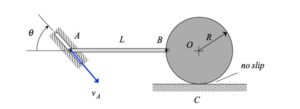| Problem statement Solution video |
DISCUSSION THREAD

DISCUSSION
For the velocity analysis of this mechanism, it is recommended that you write down three vector velocity equations: 1) relating the motion of O and C; 2) the motion of B and C; and, 3) relating the motion of A and B. Solve the resulting scalar equations from these vector equations for the angular velocities of AB and of the disk.
For the acceleration analysis, repeat the above process, but now use the three acceleration equations. Solve the resulting scalar equations from these vector equations for the angular accelerations of AB and of the disk. Please note that the acceleration of the no-slip contact point is NOT zero. Please read this page from the lecture book for an explanation as to why C can have a non-zero component of acceleration in the direction normal to the surface on which it rolls..
For example, the velocity and acceleration equations for link AB are given by:
vB = vA + ωAB x rB/A
aB = aA + αAB x rB/A - ωAB2*rB/A
First need to find Vb in terms of A and Vb in terms of C. This will give the angular velocities. For accelerations you will need ab in terms of A and ab in terms of C, you will also need ac in terms of O to reduce a variable.
Would the velocity of point C be zero? also would the velocity of O not be zero?
the velocity of C should be 0 since it is the point of contact for no slip. The velocity of O has to be nonzero for any rolling to occur
You are correct that velocity of point C is zero. The velocity of point O is not equal to zero because as the disk rolls, the center point O is continuously moving.
A helpful thing to know with this problem is that the velocity of O only has one directional component (x or y), finding zeroes like this helps you to eliminate terms in your system of equations, making it possible to solve for the various unknowns!! That's the key: finding those values that you can replace with a zero.
Is Vo necessary to calculate what is being asked? I've written out a system with Vb and Ab in terms of a and c and was able to solve for angular velocity and acceleration of AB and disk, but I did not take into consideration anything with respect to O
I am also wondering the same thing. I was able to find angular velocity without the need to solve the equation relating velocity of O to C... I am still working on the acceleration but it looks like it is possible to just use two vB and two aB equations. Maybe there's an alternate way to solve the problem using point O?
EMILY: If you consider the vector equations coming from the acceleration relations using AB and BC, you will have three unknowns: alpha_AB, alpha_disk and a_Cy. Those acceleration relations produce only two scalar equations. Therefore, you do not have enough equations to solve for the unknowns without the acceleration equation relating O and C.
I cannot see your work, but if you had said that the acceleration of C was zero, that may have allowed you to solve the problem; unfortunately, your solution would be incorrect since the acceleration of C is NOT zero.
In short, it is not possible to solve the acceleration equation without the kinematic relations between O and C.
When the question asks to find the disk's angular velocity, does it mean omega CB?
Yes, angular velocity is a measure of the motion of a rigid body. Therefore, for any two points on that rigid body, you would use the same omega.
Can I assume that the disk on the right hand side will rotate counterclockwise?
Yes, in this case the direction is CCW (+), but the direction is found through solving the problem.
Would it be safe to assume that point O only moves along the surface/x-axis?
It is not really an assumption. As the disk rolls along the flat surface, the center O remains at a constant distance R above that surface. So, yes, O moves along a path that is parallel to that surface.
Since the velocity at point C is equal to zero, can we assume that the acceleration at point C is also zero?
As covered in class, the no-slip contact point on a fixed surface (as is point C) will still have a non-zero acceleration component perpendicular to the surface on which it rolls. Please see the link above in the DISCUSSION that connects to a page of the lecture book covering this topic.
Remember to solve for the initial acceleration of C in the y direction because we know the acceleration would be 0 at C in the x direction